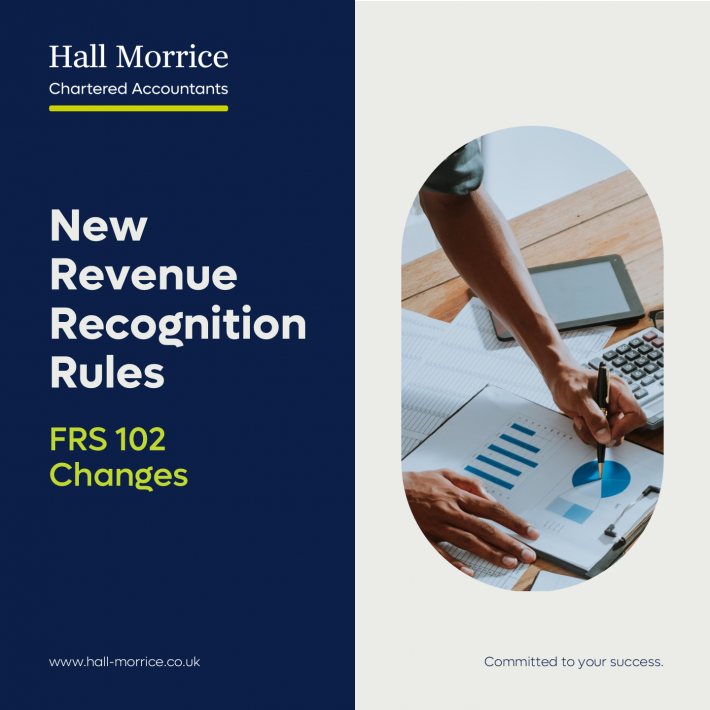
Our previous articles in the series, What You Need to Know About the Major FRS 102 Changes and Is Your Business Ready for the New FRS 102 Lease Accounting Changes? introduced the upcoming amendments to FRS 102, which take effect from 1 January 2026 and elaborated further on the impact these amendments will have on lease accounting.
Another area to be significantly impacted by the upcoming changes is revenue recognition and how to account for contracts held with your customers.
These changes represent one of the most significant updates to FRS 102 in recent years and Hall Morrice is ready to support businesses through every step of the transition. Whether you are a growing SME or a larger organisation, our experienced team can guide you through impact assessments, system changes and strategic planning. These changes matter to finance teams, business owners, lenders and investors, with potential effects on borrowing, financial reporting and tax. Early preparation with expert advice can help you avoid misstatements and stay ahead of compliance risks.
As part of the latest amendments to FRS 102, a new revenue recognition model is being introduced that aligns more closely with IFRS 15. The revised model brings greater consistency and comparability in financial reporting by applying a principles-based approach to all contracts with customers, regardless of the nature of the goods or services involved.
In simple terms, this means your business will need to match revenue with performance – recognising it only when specific obligations to the customer are fulfilled.
At the core of the revised standard is a five-step model for recognising revenue:
While conceptually straightforward, the practical implementation of this model presents a number of challenges for entities, particularly those with complex or bundled offerings, or contracts that include variable pricing.
Hall Morrice can help you assess how each of these steps applies to your contracts and reporting processes, helping you minimise disruption and reporting risk.
One of the more significant changes is the requirement to break down a contract into distinct performance obligations. These are components that the customer can benefit from either on their own or together with other readily available resources.
Under the previous version of FRS 102, these elements were often accounted for as a single deliverable. The new model requires entities to identify and assess the separability of individual goods or services, which may not have been separately accounted for in the past.
In practice, this can be difficult, especially where goods or services are bundled into a single offering (e.g. software with installation, ongoing support, or warranties). Businesses will need to assess:
Our team supports clients by reviewing sample contracts and helping to identify and document performance obligations.
Under the new model, the total transaction price must be allocated to each identified performance obligation based on their relative standalone selling prices. This can be particularly challenging when:
This may require the use of estimation techniques, such as the adjusted market assessment or expected cost-plus margin approach, and a greater degree of professional judgement and documentation.
Entities must determine whether revenue should be recognised at a point in time or over time. For many service-based businesses or long-term contracts, such as construction or maintenance, this assessment will be critical.
Revenue can be recognised over time if:
If one of these conditions is met, the entity must choose a method of measuring progress, either output-based (such as milestones) or input-based (such as costs incurred). Each approach has strengths and limitations, and care must be taken to ensure it reflects the substance of the arrangement.
This will be a significant change for many businesses, and selecting the right measurement approach will be crucial. Our team can help you evaluate your current practices and align them with the new standard, so you're ready well before the deadline.
Contracts that include variable consideration, such as volume discounts, performance bonuses, or penalties require further consideration. Entities must estimate the amount of variable consideration to include in the transaction price, but only to the extent that it is highly probable that the entity will be entitled to this consideration.
This introduces subjectivity and the need for careful estimation and ongoing reassessment as circumstances change. It also affects the timing of revenue recognition and may lead to the recognition of contract assets or liabilities that were not previously captured under the old FRS 102 rules.
The revised model may impact the timing of revenue recognition, which in turn affects key balance sheet figures such as:
Additionally, the new disclosure requirements under FRS 102 place a greater emphasis on transparency. Entities are required to explain:
The changes to FRS 102 will require many businesses to re-evaluate their existing contracts, pricing models, and revenue recognition policies. Key steps include:
These steps can take time to implement, so it's important to start early, especially if your business deals with complex, multi-element contracts.
The upcoming changes to FRS 102 will have a significant impact on lease accounting and revenue recognition. While businesses have until 1 January 2026 to prepare before the changes, it’s essential to start planning now to understand the effects on financial statements, KPIs, and disclosures.
Hall Morrice has been closely monitoring developments in this area and is available to assist with your transition process. We’ll work alongside your team to make the changes manageable, reduce disruption, and help you maintain confidence in your reporting.
Whether you need guidance on how to approach the transition independently or are looking for comprehensive support throughout the process, please reach out to Paul Archibald (p.archibald@hall-morrice.co.uk) for expert advice and tailored assistance.